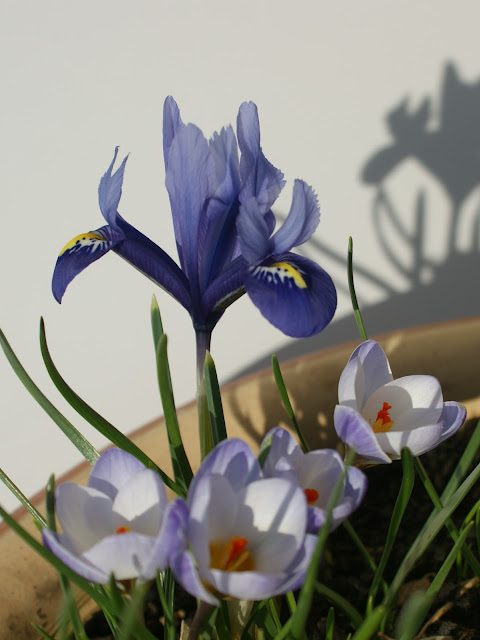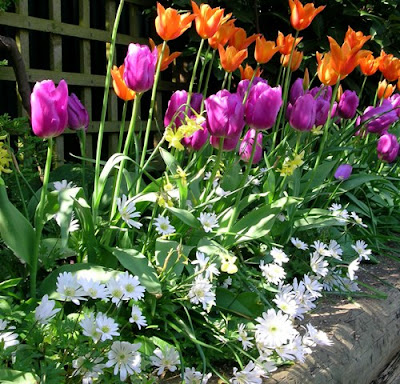Wednesday September 19th, 2012
Bulbs really are the gift that
keeps on giving. They are very undemanding. Most of them flower for years with practically
no maintenance. They come in all shapes and sizes from the stately
Mediterranean Bells (Nectaroscordum) to colourful little crocuses. And there is a bulb for nearly every month of the
year!
After the winter solstice the first
bulbs to emerge from the ground are snowdrops (Galanthus) and winter
aconites (Eranthis). The winter
aconite is a cheerful buttercup yellow flower which often appears before the
snowdrops. Both of them look charming clustered around the base of tree trunks
but thrive practically anywhere.
 |
| Snowdrops look great in groups |
In February you can look forward to
dainty little species Iris which prefer well-drained sunny spots. They are
perfect miniature versions of the large irises and a delightful splash of
colour while winter is still with us.
 |
| Species Iris 'Harmony' and Crocus Tomasinianus |
With March comes an avalanche of
bulb activity. Easy-going crocuses, particularly suited to lawns, come first
followed by the daisy-like flowers of windflowers (Anemone blanda) which have pretty, ferny foliage, unlike many
bulbs. Glory of the Snow (Chionodoxa)
is rarely seen but very easy to grow with star-shaped white or blue flowers and
obliging minimal foliage. March is when the daffodils first appear. We are
spoilt for choice with daffodils but one of my early favourites is the little
Minnow which has soft, yellow flowers. Clients sometimes tell me they don’t
like yellow flowers but daffodils can come in white, cream and a soft cool yellow
which is very different from the often disliked strident yellow of some
daffodils. Beautiful white daffodils include Thalia and Mount
Hood, both of which appear in April. Baby Moon is another April daffodil
that is only 15cm high and great for edging the border.
 |
| Beautiful white daffodil 'Mt Hood' |
Early tulips also appear in April. Tulips
tend to tail off after a couple of years and many people recommend replanting
every year. I find replanting every two or three years is sufficient. The nice
thing about replanting tulips is that you can ring the changes. Tulips are a
chance to be bold. They are not around for long so you can play with some
vibrant colours to give you a lift at what can be a rainy, grey time of year. A wonderful deep crimson scarlet is Couleur
Cardinal which blazes across the garden in late April. Lily-flowered tulips,
flowering in May, are very graceful. I have often used the orange Ballerina and
White Triumphator. May is the
traditional month for tulips and a popular favourite is the purple-black Queen
of the Night – order early, though, suppliers run out quickly! A black and
white mix, use Maureen for the white, can look dramatic. Another rarely seen
bulb that flowers from late April through May is the Star of Bethlehem (Ornithogalum Umbellatum). They are not
fussy, liking either sun or partial shade, with white starry flowers.
 |
| Tulips 'Purple Prince' and 'Ballerina' looking great with Anemone Blanda and daffodil 'Tete a Tete' |
Most gardens run out of bulbs
as they enter June but the fun doesn’t have to stop at the end of May. Dutch
Iris are incredibly easy-going small bulbs that are easy to plant and provide
weeks of beautiful colour. Alliums start in May, for example the popular Purple
Sensation, but different cultivars will carry on into July. The flower heads of
the larger types, such as Schubertii, persist in the border for months. Alliums
are a popular sculpture subject but the genuine article is just as beautiful
and much cheaper!
There is a quiet time in August
bulb-wise but in September the cyclamens appear, which are corms strictly
speaking. Cyclamen hederifolium, the ivy-leaved cyclamen, flowers from
September to November. The attractive silvery foliage makes good groundcover,
once it is established.
And then it is nearly time for
January and winter aconites!
The wonderful thing about these
bulbs is that they can all be planted at the same time in one big push. I don’t
plant bulbs too early because if you have a sunny October they can get confused
and start too soon. I have had success with bulbs planted as late as December
but I wouldn’t recommend it. Frozen or saturated ground is not great for bulb
planting. The ideal time is mid-October. For maximum impact plant bulbs in
groups of at least twenty. Scatter them on the ground and then plant them where
they land for a natural effect.
A great
bulb supplier is http://www.gee-tee.co.uk/
. You can only buy in bulk but why would you buy less than ten of these little
beauties?

No comments:
Post a Comment